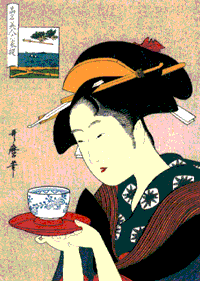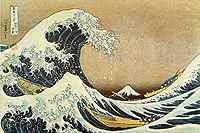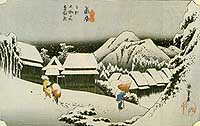Ukiyo-e

Waitress Okita from the Naniwaya Tearoom - Utamaro
The name of this art form literally means pictures of the floating world. The term 'floating world' refers to a generally hedonistic way of life, and was often used as a euphemism for the bars and houses of ill-repute which were so popular among artists and literary types in pre-war Japan. Ukiyo-e wood-block prints first appeared early in the Edo Period (1600-1868) and depicted stories set in this after-hours world.
Flashy kabuki actors and stylish courtesans were the most popular subjects. Later artists started depicting scenes from nature and works such as Hokusai's views of Mt. Fuji (see below) are among the most famous today.
The prints were a collaboration between artist, publisher, wood-block carver and printer although they are almost always accredited to the artist and publisher only.
Ukiyo-e were often used for book illustrations but really came into their own as single-sheet prints. They played a role much like modern-day pulp fiction and thanks to a rapidly increasing level of literacy, became extremely popular among the middle class. Another role was that of posters for the kabuki theater, which was also rapidly gaining in popularity. Ukiyo-e also played their part in the development of Western art in the late 19th century, influencing such important artists as Van Gogh, Monet, Degas and Klimt.
In the mid-18th century, techniques were developed to allow full-color printing and the ukiyo-e which we see reproduced today on post cards and calendars date from this period on. Utamaro and Hokusai are the big names from this period, and other prominent artists include Hiroshige and Sharaku.
Kitagawa Utamaro (1753-1806) is famous for his depictions of beautiful women from the tearooms (above), shops and pleasure quarters of Edo. He also designed some of the most beautifully illustrated books in the history of ukiyo-e.
Katsushika Hokusai (1760-1849) is best known for his nature scenes and his series 'Thirty-six Views of Mt. Fuji'. This series started a whole new style of landscape ukiyo-e. The famous illustration of a giant wave engulfing fishing boats, with Mt. Fuji merely a background detail (top right), is one of the most familiar Japanese works of art.
Ukiyo-e remain part of the Japanese cultural identity today and elements of the more famous works are often incorporated into modern art and design. Reproductions can be picked up for a very reasonable price in souvenir shops. They make excellent souveniers for anyone who wants to take home something quintessentially Japanese (and light!).

Beneath the Waves off Kanagawa (from the series '36 Views of Mt. Fuji', 1831) - Hokusai

Kambara (from the series '53 Stations of the Tokaido Road', 1833-4) - Hiroshige
For a good, and entertaining, read about what remained of the Edo entertainment districts in the first half of this century, you could do worse than check out Kazuo Ishiguro's novel 'Artist of the Floating World', short-listed for the Booker Prize in 1986. The writer grew up in the UK and writes in English.
Although the golden age of ukiyo-e is long since passed, there are some still working to keep the art form alive today. Among them, and probably the one doing the most to bring this form of art the outside world, is English-born Canadian Dave Bull. Over several decades he has not only refined his craft but also explored many new ways to present and promote his artwork. Through his Tokyo-based Mokuhankan project he has established a "woodblock print publishing venture" which harnesses the skills of other printers in an effort to prevent it from becoming a dying art. And now he even offers an event space where visitors can take part in "print parties." All this an more can be explored from Dave's main portal, Woodblock.com.
Some other pages you might enjoy:
